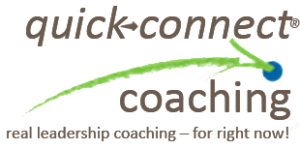
quickconnect® coaching provides you with an affordable, targeted, virtual coaching experience ̶ for your specific needs.
These coaching engagements are typically targeted, often 1-3 sessions in total, and they deliver lasting results.
Clients can purchase individual sessions or a block to “bank” for use with one or more team members.
What holds you back from becoming a more effective leader? Or getting that promotion? Or having a high-achieving team?
quickconnect® coaching can help you get to where you want to be by focusing on specific development needs.

(Assessment costs shown are in addition to the per session hourly rate)
30-Minute Discovery Session Phone or Video Call
A No-Commitment, Free Consultation to:
$295 for the First Session; $275 for each Additional Session
Get started right now.
Click on the Book a FREE 30-Minute Consult Now! button to schedule your 30-minute complimentary consultation to see if quickconnect® coaching is right for you.
Our on-target® coaching product is a full service coaching solution that integrates stakeholder input over a 6-12 month engagement, providing real business results.
In today’s fast-paced and ever-evolving technological landscape, it’s crucial for organizations to not just have skilled technical leaders but also develop them into great people leaders. Great leaders inspire, motivate, and drive their teams to achieve exceptional results.
Technical leaders are not limited to technology and engineering; they can also come from finance, sales, product development, medicine, data analysis, nursing, logistics, and operations.
The expectations and success profile changes considerably and leaders often need support as they navigate the next phases of their careers.
The following strategies can help technical leaders transition into great leaders:
1. Foster Emotional Intelligence
Emotional intelligence (EI) is a key trait of great leaders. Leaders with high EI are self-aware, can manage their behavior in various situations, and use empathy to coach and mentor their teams. They create a psychologically safe environment where team members feel valued and understood. To develop EI in technical leaders, organizations must provide training and coaching that focuses on self-awareness, empathy, and effective communication.
2. Encourage Continuous Learning and Development
Great leaders are lifelong learners. Encourage technical leaders to continuously develop their skills and knowledge through training programs, workshops, and conferences. Provide opportunities for them to learn about leadership, management, and other relevant topics. This not only enhances their technical expertise but also equips them with the skills needed to lead effectively.
3. Promote a Culture of Coaching and Mentoring
Coaching and mentoring are powerful tools for leadership development. Urge technical leaders to seek out mentors who can provide guidance and support. Additionally, strive to promote a culture where leaders are encouraged to coach and mentor their team members. This helps build strong relationships, fosters a sense of accountability, and drives performance.
4. Develop Strong Communication Skills
Effective communication is essential for great leadership. Technical leaders should be able to articulate their visions, provide clear instructions, and give constructive feedback. Encourage them to develop their communication skills through public speaking courses, coaching, and regular practice. Strong communication skills help leaders build trust and rapport with their teams.
5. Focus on Building High-Performing Teams
Great leaders know how to build and lead high-performing teams. Support technical leaders by focusing their development on team building, delegation, and collaboration. Provide them with the tools and resources to create a cohesive and motivated team. This includes setting clear goals, providing regular feedback, and recognizing and rewarding achievements.
6. Embrace Change and Innovation
In the ever-changing world of work, great leaders must be adaptable and open to change. Encourage technical leaders to embrace innovation and be willing to take risks. Provide them with opportunities to lead change initiatives and drive innovation within their teams. This helps them stay ahead of the curve and fosters a culture of continuous improvement.
7. Prioritize Employee Well-Being
Great leaders understand the importance of employee well-being. Encourage technical leaders to prioritize their team members’ mental and physical health. This includes promoting work-life balance, providing support for stress management, and creating a positive work environment. When employees feel supported and valued, they are more likely to be engaged and productive.
Conclusion
Developing technical leaders into great leaders requires a multifaceted approach that focuses on emotional intelligence, continuous learning, coaching, communication, team building, innovation, and employee well-being.  By implementing these strategies, organizations can cultivate leaders who excel in their technical roles and inspire and motivate their teams to achieve greatness.
By implementing these strategies, organizations can cultivate leaders who excel in their technical roles and inspire and motivate their teams to achieve greatness.
For organizations looking to develop the leadership they need for success, leadership coaching is a valuable tool that can help develop best-in-class strategies to bring out the best in each leader. Connect the Dots offers targeted coaching solutions that deliver a meaningful return on investment for companies looking to hone their leadership teams. Contact us today to learn more about how we can help your technical leaders transform into great people leaders.
It’s wishful thinking to imagine difficult conversations will never arise in the workplace. As inevitable as it is uncomfortable, you’ll likely have to initiate a challenging conversation with a colleague sooner or later. Whether dealing with differing opinions, navigating sensitive topics, or addressing conflict, finding the right way to approach this tough task will help you improve the likelihood of a successful outcome.
When Are Challenging Conversations Necessary?
As much as you may try to avoid getting stuck in a difficult conversation, many issues within the workplace will not dissipate if they’re not addressed. Still, simply ignoring the problem at hand is the way that 53% of employees choose to handle a “toxic” situation. Only 24% of employees would choose to address the situation directly. Avoiding a challenging conversation can prolong the problem, lower team morale, and hurt business productivity.
For context, let’s imagine a scenario warranting a difficult workplace conversation. You and a colleague may share responsibilities–whether that’s managing client communication, handling administrative tasks, or producing certain deliverables–but you find them delegating tasks to you. Maybe they’ve started to hand off client onboarding, report generation, or other tasks they also should be managing. As your workload increases, finding the right way to discuss this imbalance with your colleague can help you remedy the situation and come to a mutually agreeable resolution. Without the right communication skills, you could be among the 49.7% of individuals who don’t report a positive outcome, such as increased stress levels, resentment towards your colleague, or lowered performance as you struggle to get all the tasks done.
Preparing For a Successful Conversation
Challenging conversations are difficult for a reason, but taking the time to prepare can help you effectively communicate your point of view without sounding accusatory or aggressive. Here are a few steps you can take to make the conversation productive and successful:
Difficult Conversations Pay Off
Even with the best preparation, tough conversations will never be fun. Still, they can have a significant, positive impact on colleagues and the larger organization. These benefits can include:
● Strengthening workplace relationships and fostering an environment of trust
● Clearing up misunderstandings or misconceptions
● Reducing workplace stress by de-escalating issues
● Improving productivity and collaboration by removing roadblocks
● Enhancing communication skills
Thus, individuals within an organization need to identify when there is an opportunity for them to address issues with a challenging conversation. Not only will they be able to seek a better outcome for themselves, but these colleagues can also drive valuable change within the organization.
For leaders who are unsure where to start tackling their team’s issues, Connect the Dots can help teams develop new tools to engage and be productive with their teammates.
Contact us to learn more about our team development and performance solutions.
As leaders continue to navigate an organizational landscape of virtual, hybrid, and in-person work, they need new competencies to foster connection of their teams and employees.
Employees who feel undervalued or disconnected have been leaving organizations far more frequently in the past two years, and it is up to leaders to reverse this trend. In April 2022, we sat down with CHROs to discuss these ongoing challenges and best practices to address them. Following is a summary of our discussion.
Discussion Points
What conversations have you had with your leadership teams?
What are you hearing from employees?
What tactics are your organizations using?
Need additional support?
As your leaders continue to stretch themselves to navigate new and challenging dynamics, coaching support can help them do so more effectively. CTD’s on-target® and quickconnect® coaching models give you the flexibility to invest in targeted coaching at any level. Effective onboarding is another tool for organizations who want to differentiate themselves as an employer. Check out our solutions for leadership and all-employee onboarding that provide a branded, customized experience for your new hires. We welcome the opportunity to talk with you about your specific leadership development needs and a custom solution.
We start with thoughtfully diagnosing the team’s current culture by using available data, assessments and interviews.
This provides the team leader with a clear view of what is getting in the way of the team’s success.
We design a series of structured team sessions that:
Measure progress by leveraging CTD’s team-connect Survey to: